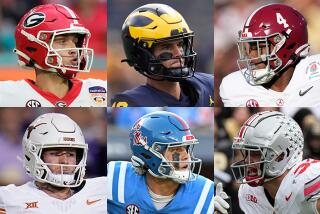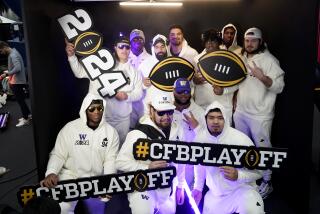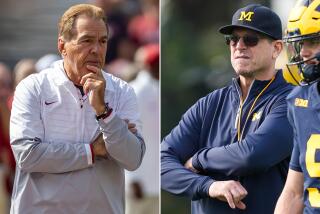Top College Teams Have Their Day in the Sun
Really and truly, the national championship of college football will be decided in the next three weeks, in two parts, both of which will be played out in Florida. Where else? Forget all those prove-nothing New Year’s Day bowl games, the ones that will match contenders with pretenders. The state of Florida will give us a champ, no matter what the outcome is for the Washingtons and Michigans.
If the champ isn’t declared in Tallahassee Saturday, when either Florida State or Miami is left standing, then one will be two weeks later in Gainesville, when Florida State visits fifth-ranked Florida. The best teams in college football are Florida State, Miami and Florida, in that order. Combined, they are 27-1, the only blemish being Florida’s early-season loss to Syracuse.
So it’s absolutely fitting that these moments in the sun belong to the state of Florida, whose year-round warmth (relatively speaking), population explosion and obsession with springtime football and track have combined to produced a three-headed monster that is in the midst of a reign of domination of college football.
As this year’s Game of the Century comes closer, people have been scrambling to figure out why Florida over other states?
California has all the same conditions, but as ESPN college football analyst Lee Corso said: “Florida’s got those three schools, California’s got about 75 schools. If California had just three schools, they’d be the greatest three schools in the universe. They’d be unbeatable. But the California kids are spread out all over the place. Okay, so every once in a while, a Florida kid goes to Notre Dame or Michigan (like Anthony Carter). But for the most part, they stay right there in Florida.”
True enough, Florida grows ‘em, and keeps ‘em. Neighboring University of Georgia, which has 104 players on its roster, has two players from Florida. Of 111 players on Florida State’s roster, 85 are from in-state. At the University of Florida, 89 of 105 are Floridians. Even at Miami, which has national appeal and a broader recruiting base, 58 of 95 scholarship players are from Florida.
Only 28 of the University of Michigan’s 92 players on the roster for Saturday’s game are from Michigan. The University of Maryland listed 35 of 104 as being from Maryland. And of the University of Washington’s 130, 60 are from within the state.
Only the University of Texas, with 125 Texans of its 131 players, hoards them the way the Florida schools do. But as Corso, who played and coached at Florida State, said, “The high school athletes in Texas aren’t as good.”
If Florida seems like a Johnny Come Lately, it is. The population explosion across the entire Sun Belt gave Florida a bigger talent pool beginning in the late ‘70s. And black players, who had been going to the Bethune-Cookmans, Florida A&Ms; and Gramblings (or to no college at all) are now critical to the success of the three Florida schools.
Beano Cook, also an ESPN college football analyst, said: “They’ve joined the rest of the country in keeping their best black athletes home. It’s interesting to note in the Northeast, the best athletes play baseball in the spring. In Florida, they run track and you can see the difference.”
The University of Florida, the oldest of the three schools, was always the royal presence on the state. The Gators got whomever they wanted in-state until the mid-1970’s. Miami got many of its instate players from south Florida, but Florida got its share. Florida State took what was left, until Bobby Bowden arrived to coach Florida State in 1976.
More changes occurred, Corso points out, when Howard Schnellenberger came to Miami and in the early ‘80s declared a recruiting area called “the state of Miami.” The Hurricanes focused on keeping south Floridians at home. Being in the top five almost every day since 1983 has only helped the pitch.
When Florida went on probation in 1984-85, “Florida State started getting a lot of players Florida would have gotten,” Corso said.
The shortsighted and conservative use of talent by the Ray Perkinses and Bo Schembechlers of the world can goof up even the most talented teams. Florida State has had a wonderfully imaginative coach in Bowden, and Miami has gone from Schnellenberger to Jimmy Johnson to Dennis Erickson, all three innovators who understand that talent is a terrible thing to waste. The best of them all may turn out to be Steve Spurrier, who pulled the Gators out of the probation doldrums faster than any reasonable person could have expected. “The three schools really have good coaches,” Cook said. “Spurrier will be the first Heisman Trophy winner to coach a national title team.”
Every year, NFL teams seem to reap the ultimate benefit. Florida, by a recent tally, has 25 players in the league, including Wilber Marshall, Neal Anderson, Emmitt Smith and Louis Oliver. Florida State has 28, including Marion Butts, Sammie Smith, Jesse Hester, Hassan Jones, the fabulous Deion and the Redskins’ Martin Mayhew.
Miami almost needs a foldout section for alums in the NFL. It was 36 at last count. Jim Kelly, Bernie Kosar, Bennie and Brian Blades, Michael Irvin and Jerome Brown. Miami alums could field a team that might contend for the Super Bowl.
More to Read
Go beyond the scoreboard
Get the latest on L.A.'s teams in the daily Sports Report newsletter.
You may occasionally receive promotional content from the Los Angeles Times.










